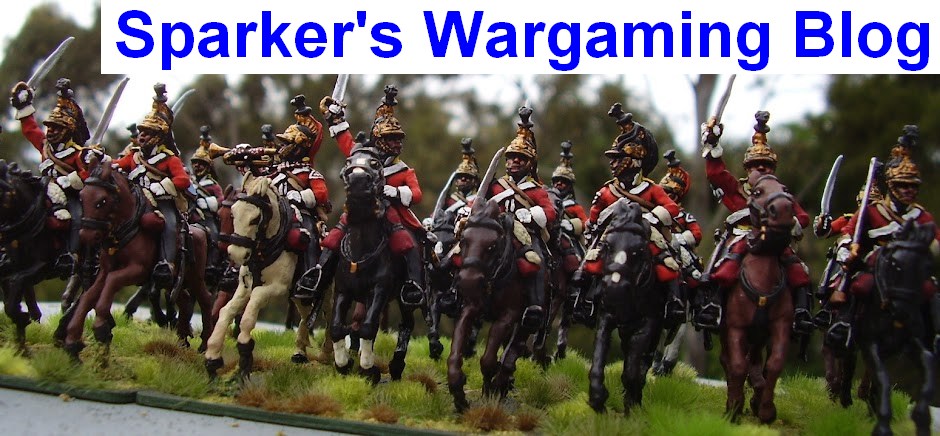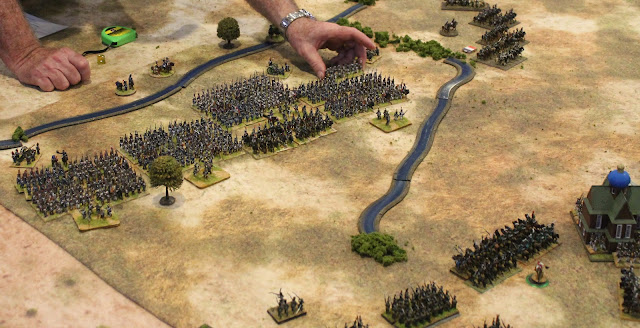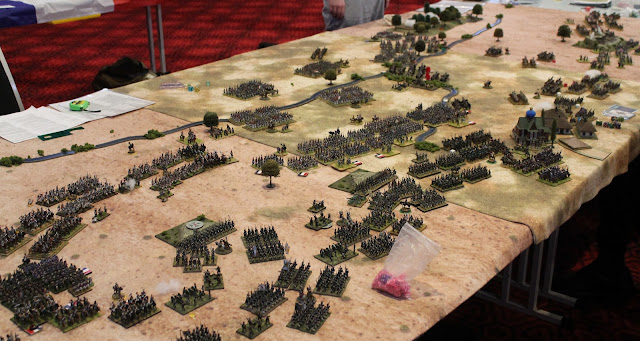The Battle of Borodino, at the time the largest battle of the modern era, has long held a fascination for me. In conjunction with the Illawarra Horse and Musketeers, my club the Wollongong Wargamers played a mega game of the Battle of Borodino on Sunday 17th November at the Bulli Woonona RSL.
We used the excellent Valour
& Fortitude rules, retaining the original 28mm distances but playing
with 15/18mm figures.
To encourage a decisive outcome, the original force ratios of 1.2:1 in favour of the French were exaggerated slightly to 1.5:1. The French had 72 infantry battalions, the Russians 48. The French had 30 cavalry regiments, the Russians 21, including Cossacks. However, as historically, the Russians had slightly more guns: 16 batteries to the French 13. To speed things up, skirmishing and open order formations were limited to 12 Russian Jaeger Detachments and 16 French Infantry Detachments. Formations were somewhat templated: Each infantry Brigade consisted of 4 line battalions and one skirmish detachment.
Corps consisted of either 2 or 4 such brigades, plus artillery, and light cavalry brigades of 2 regiments.
Cavalry Corps consisted of 2-3 Heavy Cavalry regiments and 1-2 Light
Cavalry regiments.
I know from experience it is hard to refight Borodino on this scale without the action degenerating into a formless scrum.
With several key wargamers unable to attend, the concept was to focus on just the centre two thirds of the battlefield: the vicinity of the Raevsky Redoubt and Fleches, below Semenovskaya. The eponymous Borodino to the north and the Utitsa mound and woods to the south would not appear on the table. This would allow a more spacious set up for the area we were representing. It was deemed that outlying corps have made their way to this central area from the flanks, and would arrive as reserves in the second or subsequent moves, as directed by C in Cs, as soon as there was table space.
They could arrive anywhere on the friendly
table edge, and were deemed to have automatically activated. However, to retain
some control over the balance of play, I as umpire had release authority over
certain key reserve formations: French Imperial Guard, Russian Arty Reserve,
Platov’s Cossack horde.
This would be a classic grinding attack/defence game with the French having a numerical superiority but having to act fast and furiously from the outset if they were to seize any objectives within 6 turns. In the event, they were plagued by failed brigade activation tests...
There were 4 objectives: the Raevsky
Redoubt, Semenovskaya, the Fleches, and one to be placed by the French C in C
anywhere along a line 18 inches in from the Russian Table edge. Victory would
be determined by subtracting defeat points from objectives at the end of Turn
6, the side with the least defeat points winning.
Terrain considerations were also simplified.
The only hill reflected was the mound incorporated within the Ravesky Redoubt model, which for this scenario, was a single Defendable Terrain Feature but manned by three units: two heavy artillery batteries which uniquely each have a with a 135 Degree arc of fire and a unique elite Jaegar. It provided Heavy Cover. The village of Semenovskaya represents two Defendable Terrain Features. The wooden buildings provided Light Cover. The Fleches were each a single Defendable Terrain Feature which could each be occupied by a Battalion of infantry if required. They provided Heavy Cover, and, for this scenario, allowed the defenders to assume the benefits of line formation. Whilst historically the streams that cover the area were fairly steeply banked, we classified them merely as Barriers costing 4 inches of movement to cover. The network of tracks and roads was not reflected.
The French
C in C placed his fourth objective well to the south, the French right, between
the Fleche objective and the Semonovskaya village one. The French C in C’s plan
was to concentrate and push hard to the right, with 3 of his 4 corps focusing
on that objective and the one in the Fleches. The Raevsky Redoubt would be
given a severe ignoring! The remaining corps on the left was simply to tie down
the Russians facing them to prevent them reinforcing to the south.
It didn’t take the Russian long to divine the French plan and they made plans to bring their reinforcements their table edge nearest the threatened southern flank. Meanwhile, all along the line the on table Russian formations assumed a very aggressive and active defense from the outset!
This movement was delayed when the French played the ‘Confusion’ fate card which delayed reinforcement moves for a turn.
The Russian left was now heavily
outnumbered, but the fleches withstood several assaults, even with French
infantry being supported by cavalry attacking the flanks of the earthworks.
By this stage the centre corps had joined the action, assault after assault steadily grinding their way towards Semonovskaya. The Russian team was making much use of General Bagration’s card to make them much tougher in melee, and their Stoic attribute was keeping them on the table even whilst shaken.
The French team were making good use of their Vive
L’Empereur, Attaque A Outrance and Les Grognards fate cards,
and their Elan attribute, to fight like demons! Brigade after brigade
wavered, with each army steadily racking up defeat points.
After turn 3 it was time for lunch, and I got a chance to assess the way the battle was going. All the intense action was down the southern end of the table.
With hindsight I realized I should have weighted the Raevsky Redoubt, such an iconic part of the battle, with double objective points to weight the battle across the whole table. In an attempt to retrieve a more widespread battle, I made an offer to the French skipper: The French Imperial Guard to come on, but with orders to take the Redoubt!
He agreed, and the 4 brigades of Imperial Guard marched onto the table; 4 battalions of Old Guard, 4 battalions of Young Guard, and the Guard Heavy and Light cavalry brigades. They looked magnificent!
But
they would have their work cut out to take the redoubt, 3 feet away, within 3
turns. Double moves are only allowable up to 18 inches proximity of the enemy,
and the cunning Russians had strategically positioned a screen of Jaeger
detachments in the way! The Emperor’s daughters narrowly failed to blast this
screen away, so now the only way they would get onto the objective in time was
if the ‘Surprise Attack’ fate card showed up in time – this allows a double
move followed by an assault…
Meanwhile in the centre and south of the battlefield the action continued unrelenting with bitter assaults and counter charges up and down the line.
Defeat points were now being incurred not so much from wavering brigades as by shattered brigades, when the last remaining unit broke!
In turn 4, their centre eviscerated, the Russian reserve Heavy Cavalry corps were committed to a series of attacks against the relentless French infantry and their supporting cavalry.
These fights went both ways, but the Russians won enough of them to hold their centre together for the time being and draw ahead in the infliction of defeat points.
But further south, eventually, the third, or was it the fourth, assault on the Fleches saw them seized by the French – one objective had changed hands!
In a nod to history, the principal
charging unit was heavy cavalry – although not the Saxon Zastrow Kuirassiere,
who had long ago been turned into mincemeat.
As
expected, the Imperial guard failed to reach the Raevsky redoubt in time to
mount an assault, although they did keep two Russian corps from moving south to
reinforce the hard-pressed Russian centre.
With barely a fresh unit on table, it was time to tally up objectives and defeat points to determine the winner. The hard fighting Russians had forced 9 defeats on the French, whilst the French had handed back 7 on the Russians, and taken one objective. Therefore, the Russians retaining 3 objectives, it was a Russian victory by 4 points! Graciously, however, the Russian C in C said that his centre was looking pretty shaky...
A close run thing! A credit to the enthusiasm and sportsmanship of the players.
From a scenario design aspect, there was room for improvement: I should have given more thought to balancing objectives to include the whole table and all players. I would also give the French C in C some extra automatic activations in the first couple of moves to get things moving early on. With some inexperienced players, ideally I should have left C in Cs free of play, or perhaps just given them key reserve formations.
On the positive side, the Order of Battle bath tubbing, a condensed sector of battlefield well spaced out, and the reserve procedure had worked to avoid a formless scrum - it was very pleasing to hear players refer to such and such Corps here and so and so's Corps over there!






























Fantastic!
ReplyDeleteI also played a large game on Sunday 18th.
26 battalions, 6 regiments and 4 batteries of French.
Attacking around 66% their numbers of Austrians in a prepared defensive posture.
It was a long grinding game.
I figure it takes 6 battalions to eject one defender form hard cover defensive terrain.
(assume friendly defenders guarding the terrain's flanks).
Imagine my surprise when I found it wasn't even the biggest game played that day. :-)
Thanks Steve! Good to see big games are as popular as ever...
DeleteAnother eye candy post their Sparker! As you say, these big games can degenerate into a formless scrum, rather like the historical action I suppose. Afterall not one of Boney's best plans fo attack for sure. Even giving the French a slight boost in numbers, it was still a tough ask to get enough victory points for a 'win'. But then you can only tell what might need to be tweaked or not once a scenario has been played at least once.
ReplyDeleteThanks for your kind comment Steve. Yes for various reasons the Emperor of Battles rejected the subtle approach and paid the price. And for my part I have learnt some valuable lessons about staging big games!
DeleteA magnificent spectacle! One of your finest, Sparker. If the players enjoyed themselves half as much as I did just reading the report, then you can be assured it was a successful game. Also - really speaks to the strength of the V&F rules, too.
ReplyDeleteThanks Fusilier! Much appreciated, and yes I think all the lads had a good time. Totally agree about the rules too!
DeleteHow many figures were on the table?
ReplyDeleteHmm, lets see - 120 battalions of 32, 52 regiments of 12, 28 detachments of 6, 29 batteries of 6 = 4,794. Not including Staff and Generals
DeleteSuperb! and V&F proving themselves once again, especially as the group are picking up on their nuances. Borodino is of course a grind with nothing for it other than that head on assault ….. ideal for edge of table to edge of table wargaming ….. none of this fancy talk about needing table space to manoeuvre :-)
ReplyDeleteLast year, I played a very clever Borodino scenario, repeated in the Shadow of Eagles rule book, but originally devised by the late Stuart Asquith, which took the six main defensive positions of the battle and lined them up, down the middle of a six foot table (longways), giving each position its own square foot of table.
In essence, this created six smaller individual points of crisis / action from one end of the table to the other, from Borodino village at one end, passing through The Great Rredoubt, Semenovskaya, The Fléches, The Woods and ending up at Utitza village at the other end of the table.
In each of those sectors were units that were just representative of much bigger forces (bath-tubbing) and it all worked rather handily, giving a themed sense of the sweeping nature of the battle in a controlled and compact way and within an acceptable playing time ….. though looking very much less spectacular than your table and the V&F rules allowing for the faster play with more troops!
Thanks Norm really appreciate your supportive comment as always. It is a grind but perhaps therein lies its fascination. Interesting way of doing it you mention there - I may try a similar approach to other battles and epochs where there are a wide spread of objectives.
Delete